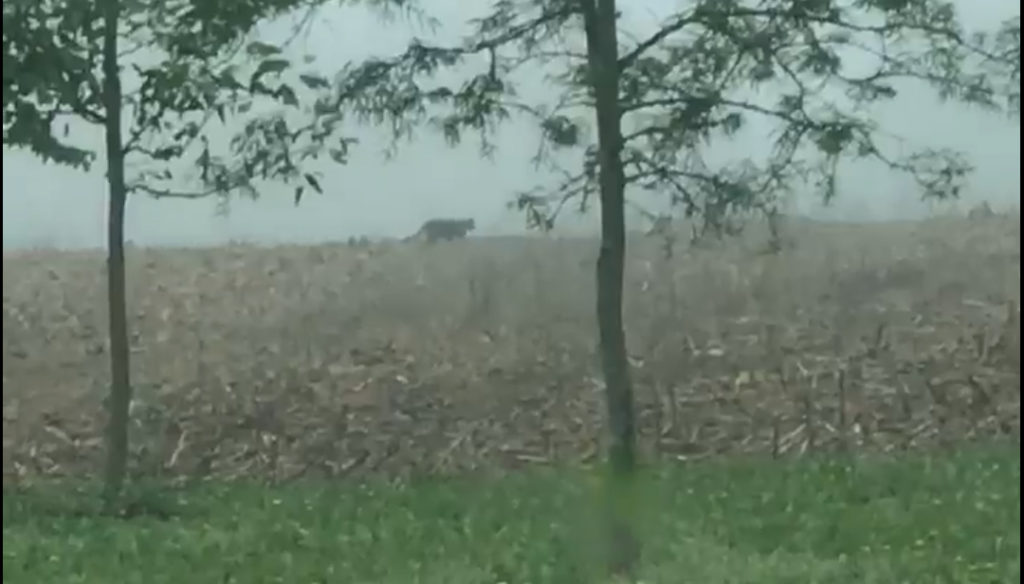
From Susquehannock Wildlife Society:
On May 31, 2018 an interesting video of an animal walking across a field was captured in the Fallston area of Harford County, Maryland during a foggy morning by Dan Jones. A debate ensued over whether the animal was a rare and incredible sighting of a cougar (either an extinct eastern cougar or western cougar that traveled a great distance outside of their known range) or just a large domestic house cat that appeared larger than it was due to the weather conditions and perspective. Our wildlife research team decided to help take the mystery out of the sighting by going to the location and comparing the size of the animal to stationary objects in the frame as well as a human subject. In this video we discuss why we have reached our conclusion as well as explaining some natural history about this species.
The video should provide our conclusion in sufficient detail but we also would like to outline a few specific items that are worth discussing given the amount of visibility, emotion and confusion that this controversial sighting created.
Why did we weigh in?
We are dedicated to science-based education, research, and conservation of our native wildlife in the lower Susquehanna River region so we consider any wildlife issues, unique sightings, or concerns in this area to be at least in part, our responsibility and of interest. We saw the video and given the collective experience in studying and researching wildlife we arrived at a conclusion rapidly. We noticed that some members of the community were making quite a few assumptions to arrive at a much more unlikely conclusion and perpetuating some rather wild conspiracy theories regarding predator introductions by government agencies that have never occurred in our area for a variety of reasons we won’t get into here. As part of our ever growing search for fact and truth in the wildlife field, we felt we could bring some calm to the hysteria and let the community know that their fear was unfounded, whether or not the animal was a cougar.
How do we know? What are our credentials?
Our team, as well as our network of partner agencies and organizations, work together to provide a wealth of collective experience in researching and identifying wildlife of all kinds. We are responsible for and trusted with identifying and collecting data for a multitude of sensitive species including some that are protected and globally rare. Our board and leadership team alone includes a master naturalist, several educators, research biologists, and an electronic media professional. We collaborated and sought out trusted outside opinions to review the footage to ensure we all came to the same conclusion, looking at the content from both a wildlife and photo/video perspective to determine how we could not only confirm to ourselves what we were seeing but present it to the public.
Perspective vs Reality
The day that we first saw the video we decided to quickly recreate the scene by using our research assistant to provide the scale of the trees and slope so that it could be compared to the size of the animal in the original. While there is more to our conclusion than just size, the scale of the cat is the easiest identifying factor to illustrate to exclude a cougar or mountain lion as a possibility. Unfortunately in our haste we didn’t match up our subject to the exact location of the animal and the lower quality of the image using only a cell phone to create it left many viewers to assume that our demonstration was flawed with the animal appearing substantially larger than it was in reality. In fact, the objects in the screen shot from the video are actually larger than our shot of our researcher (note the wider tree width and crop area height), making the cat appear larger than it should have. We take ownership for our mistake and will now correct it.
First attempt at creating a comparison shot
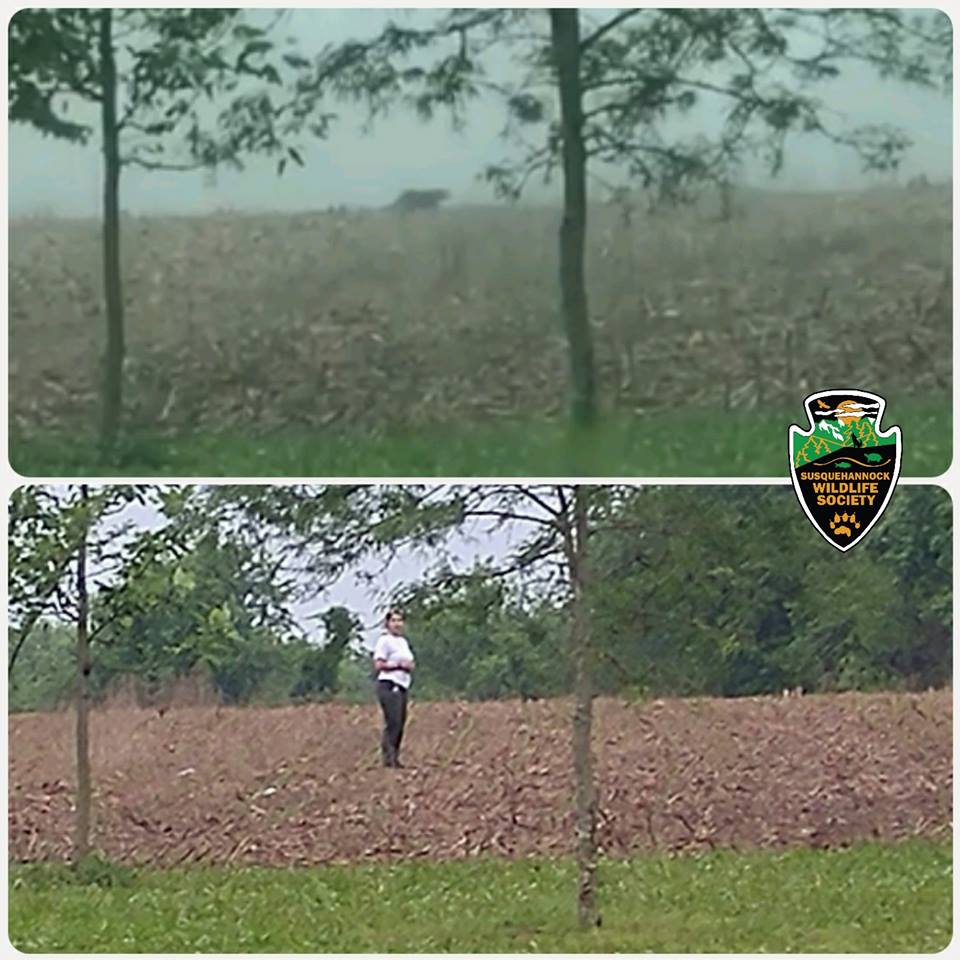
We listened to the feedback and returned to create another demonstration that took into account the concerns of those who felt that the perspective was skewed and that we provided no proof to the size or scale of the image. The first goal was to match up the perspective, hill, and subject as best as we could. This attempt is much more accurate while still showing the same conclusion of the size and scale.
Second attempt at creating a comparison shot
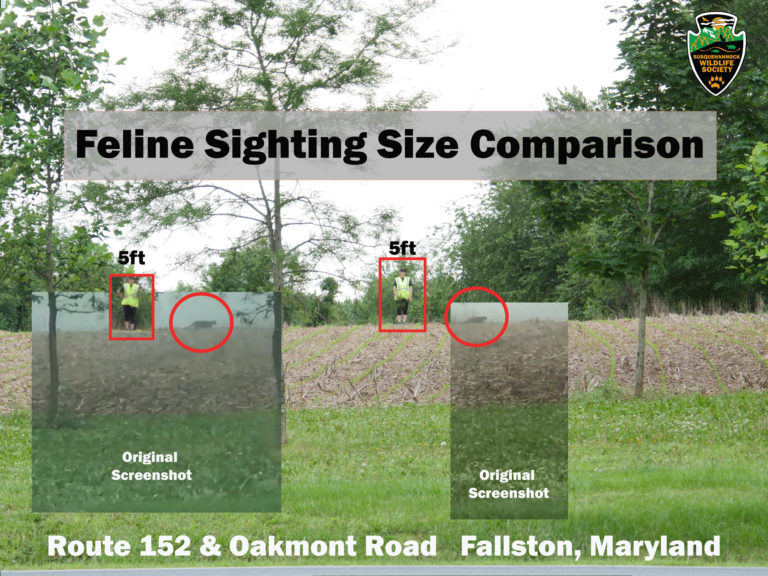
A few notes about our second attempt are that from the video the hill appears to be much steeper than it is. When pulling up to the intersection where the animal was seen, you quickly realize that the hill that many viewers assumed was rather impressive, giving way to the assumption of a much larger animal moving across its ridge. The elevation is nothing more than a slight incline from the mowed grassy area on the shoulder of Route 152 to the middle of the rise as seen from the road.
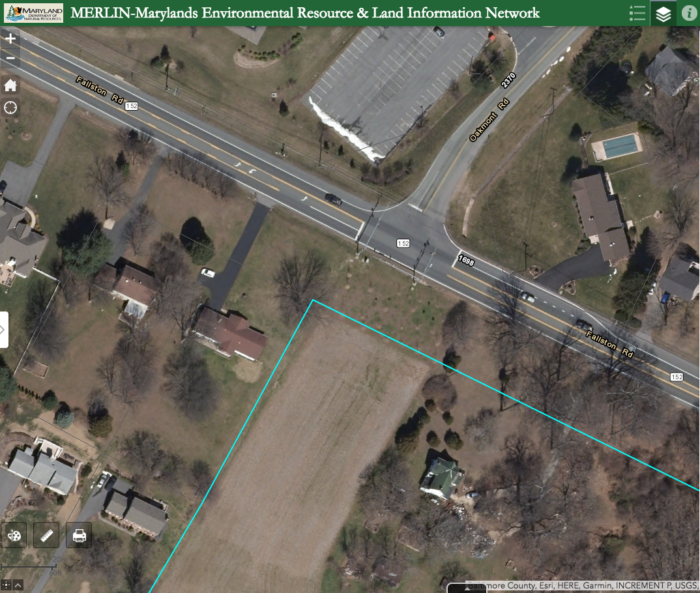
The trees also can appear to be larger than they are but they are actually just part of a fairly recent roadside reforestation project and rather small compared to how they look in the video to some viewers.
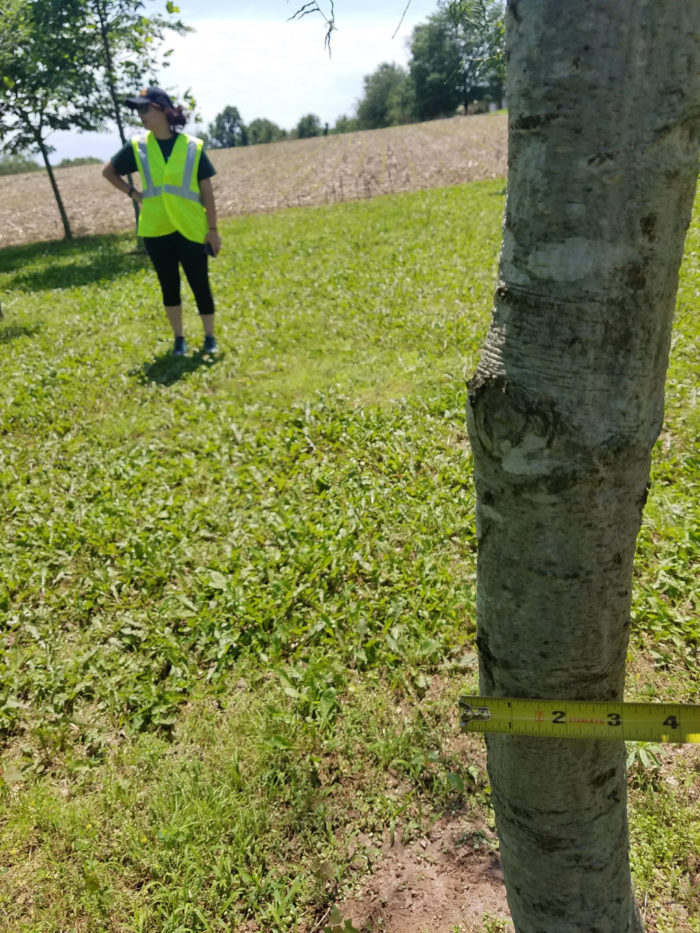
We do believe that the fog had a lot to do with the perspective being hard to judge as well. Many commenters on our social media post suggested that we didn’t even visit the same location for our comparison. We easily proved this by showing the same trees, landscape, and road signs present in the intersection. We understand that the fog did a good job of obscuring the tree line in the background and likely made the cat stand out more than it would have in normal conditions. The fog created a backdrop that really made the hill look taller and perhaps even the animal look larger.
While conducting our second comparison we were fortunate enough to run into Dan Jones who filmed the original video. He gave his side of the story and pointed out that he was an avid hunter who wouldn’t have filmed the animal if wasn’t out of the ordinary. We certainly don’t dispute that as this unusual combination of factors created a situation that would make anyone give a puzzling look and try to figure out what they were looking at. We are glad Dan took the time to share the video with us all and start the conversation about local wildlife. Dan was kind enough to take a photo of our researcher on the hill while in his truck using the same phone he filmed the video with (although one was a video and one a still shot), from the same perspective. This helps us gauge not only the difference of the same view on two different days but also provide the scale comparison from the original source.
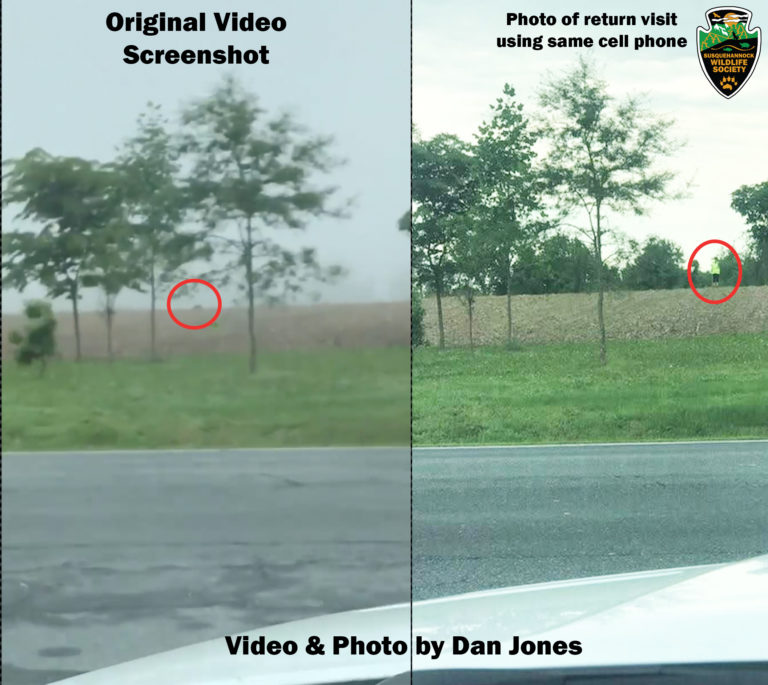
When you look at this evidence it is hard to justify that this animal is a cat as large as a cougar given the scale of the items surrounding it including our human subject, the trees, and cut cornstalks not to mention the behavior of the animal, short legs, long tail, hanging belly, and dark coloration that all point to a large feral domestic cat rather than a cougar.
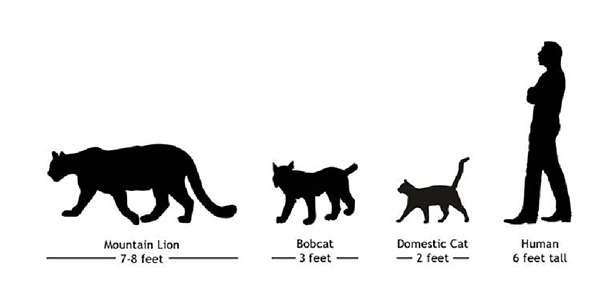
Graphic from www.openspace.org
Any other evidence?
We knocked on the door of the home associated with the agricultural parcel where the animal was sighted. The gentleman at the house gave us permission to walk around the field to look for evidence and create our comparisons. We asked about any sightings and if there were any large feral domestic cats in the area. He stated that there was a large colony of around a dozen feral cats around the property and a few larger male cats that pass through on occasion. We ventured out into the field to look for tracks, knowing that with the time that had elapsed and frequent rains there wouldn’t likely be evidence even if the animal was a large cat like a cougar. Our hope was that if an animal had a home range it may return to the area with some regularity. We did our best to zig zag across the field and couldn’t find any feline tracks or scat (feces), large or small. The only tracks that we saw were those of white-tailed deer.
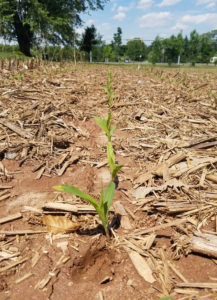
What about the other sightings?
This isn’t the first cougar sighting in the area and it won’t be the last. We spoke to several other residents who had stories of things they or folks they know have seen that they believe to be cougars. Many commenters on our post provided recollection of past sightings in our area or surrounding states as evidence that this particular video was in fact a cougar. To start, even if every other sighting was verified, it still wouldn’t bring us to the conclusion that the animal in this video was a cougar. We have not cited the absence of cougars as the reason that we have deemed this sighting as a domestic house cat. While we have yet to see any concrete evidence from any of these recent observations that we can verify, we have no reason to state that they are not being truthful. We believe everyone saw something, whether it was a black bear, coyote, house cat, bobcat, or a cougar that either was kept as a pet and escaped or migrated east on its own. We can give our opinion based on the likelihood of each animal in our area, with a cougar being about the rarest, but not impossible given there have been verified sightings in the east.
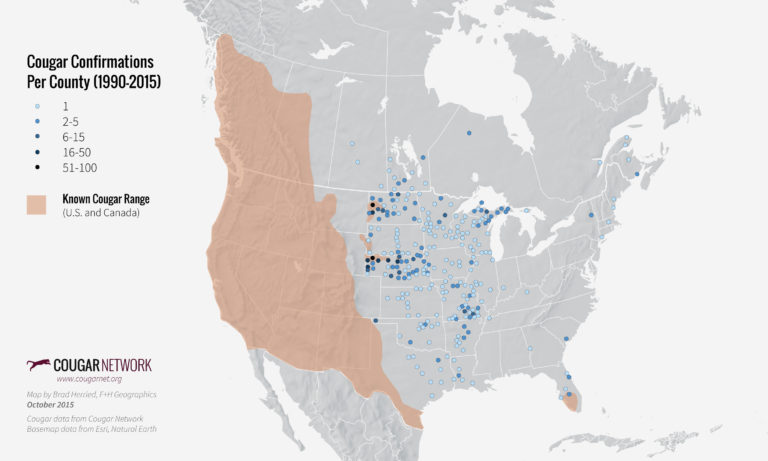
Image from National Geographic, Data from Cougar Network (2015), Map Brad Herried
With something as rare as a cougar that doesn’t currently occupy our area as a known range, we and our government wildlife agencies need proof of their existence. If someone reports a black bear, it is generally accepted as likely since they are confirmed to visit our area with some frequency. Eastern coyotes are well established and have breeding populations so we don’t have to go through the same level of proof to verify a sighting since we can say there is a high probability that a report is correct given their abundance. As we often see with the cottonmouth / northern water snake confusion here in Maryland where we get countless reports each summer of a snake that is not found in our area, many times the untrained eye misidentifies a wildlife species for another. If any species that has never or rarely been verified in our area is found, it will be a notable record to the scientific community with management and conservation implications so solid proof is a requirement. We will never say never when it comes to a sighting but there is a wide range of likelihood depending on the species and whether it is something that could be a released or escaped pet for instance (Remember, we once found an alligator in Harford County). Our job is to report on what we can prove using sound science and experience while trying to help the public in learning how to properly identify wildlife that understandably may be difficult to do so for those not in our field.
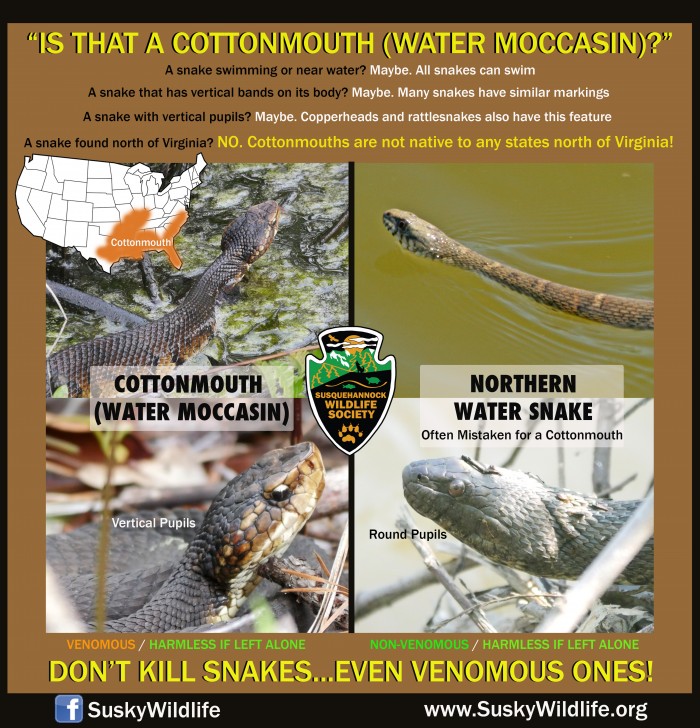
This isn’t our first time weighing in on this issue. Just this February we posted a story about the declaration of the Eastern Cougar as being officially removed from the endangered species list after earlier being declared extinct where we mention some of the sightings that still persist and our philosophy when it comes to this discussion. View the article here
Going back even further, journalist and one of our founding board members, Brian Goodman, had tracked reports of cougars in the area and at the time, mistrust of government agencies on taking them seriously, reporting on it in The Dagger. View the article here
Our point? There have been many interesting reports and this is not a new phenomena. We have to treat each ease on its own merit and weigh the evidence. We are here to listen and give our opinion from our perspective.
Unfounded Fear. What if there really ARE Cougars here?
So what if this sighting WAS a cougar? Would that mean there would be a mandatory evacuation of Harford County and no child or pet would ever be safe again? It is unfortunate that a similar level of fear and misinformation that caused the extinction of the Eastern cougar in the first place still exists within some portion of the community. We see this type of frenzy surface after reminders that the Eastern coyote migrated here and is now part of our local ecosystem or each time a black bear wanders through the region from Pennsylvania or Western Maryland to search for a new home (Check out the video we produced a few years ago discussing bears). What is lost on many is that a large portion of Americans live alongside large predators every day and pay them little mind. The southeast has the American alligator inhabiting golf courses and neighborhood lakes with regularity. Black bears are established in at least 40 states where they can find suitable habitat but almost always avoid humans. The cougar can be found in much of the western desert and mountain habitats including along incredibly dense cities like Los Angeles as in the famous example above as long as food and habitat still exists. Do attacks occur from these predators? Certainly, we have all heard the news reports where a pet, livestock or even a person is unfortunately attacked by an animal that is usually old, sick or defending its young. The benefit of having these animals in the ecosystem far outweighs the risk. Having the predator/prey balance intact creates a healthier environment for all us as was illustrated by the return of the gray wolves in Yellowstone National Park or the red wolf in coastal North Carolina. So what do we do if cougars do one day return to our region? As others around country have done, we learn to take proper precautions when hiking, jogging and using the outdoors. We keep an eye on our pets and don’t leave them alone outside at night. We take measures to protect livestock by using dogs and installing proper fencing. The chances of any negative interaction, even where numbers of these animals are healthy and well established are incredibly low. We hope one day, maybe, we might see such a magnificent creature as the cougar return to our beautiful landscape here in the lower Susquehanna region. Until then, keep the reports coming and keep your eyes open, you never know what might be out there to discover.



To me, the head looks like a domestic cat.
The investigators did a very thorough job. The should be praised for their hard work in attempting to verify whether this was a cougar or not. The video was well done and informative. While proving that there was not a cougar sighting they respected Mr. Jones and the property rights of the owner of land where the sighting occurred.
Well Golly E….Did they call David Ryden to make sure they got it right? Maybe they sent Gahler out to identify it.
It’s a freakin cat and thanks to whomever picked the music in that video I know have a migraine.
The investigators have done a fine job of replicating the conditions on the original video. However, they have not, and perhaps cannot, establish where the feline was when traversing the field in terms of distance from the videographer. It could well be that the animal was further away — making it appear smaller than it, perhaps, actually is. Note that the women’s shoes are visible as she lifts her feet to walk– suggesting that she is walking at the crest of the slope or, perhaps, even on the downslope side nearest to the photographer; whereas the feline’s paws are not visible. This suggests that the animal was further away and, perhaps, even slightly over the crest of the slope. FWIW.
its gate is way too fast and tail movements as well to be a big cat of 150-250 lbs…carefully watch its feet and tail at normal speed.
You may be correct in your assessment and you appear to be well versed in this subject.
But I’m still not convinced (either way). According to this accompanying fact sheet, an adult Eastern Cougar could be as small as 80 lbs and a cub at 6 months would be typically in the 30-40 lbs range. That small a creature could be the one in the video.
https://www.mountainlion.org/us/ny/AGENCY/NY-A-NYSDEC-2013-Eastern-Cougar-Fact-Sheet.pdf
After re-reviewing the video, I remain of the opinion that the feline appears to me to be larger than a domesticated cat (including a Maine Coon – which would be eliminated anyway as it has a bobbed tail). And the Eastern Cougar wouldn’t be the first animal to be resurrected from “extinction”.
In any event, I stick by my original proposition that the woman appears to be closer to the videographer/photographer than was the feline making the feline to appear smaller in comparison to the human.
Moreover, the article did not address the respective focal lengths of lenses that were used by the original videographer and the subsequent investigators. As such, we do not have a key fact that would assist us to judge how different focal lengths might have distorted our perceptions of distance and, derivatively, of the size of the two subjects.
So I think we have to accept the Scottish verdict of “not proven”. But that doesn’t mean “not exist”.
Theres also a recitent woodape population in the county.
Don’t believe me go to gunpowder state park at night and walk deep into the woods.
Shades of Bob Chance and Big Foot!
Piss off.
Very interesting!
Every year we have a few of these… just like roaming bears… lol
Interesting article, I saw the video and could tell almost immediately (3rd time watching it for sure) that it was not a cougar but in fact a house cat. The biggest clues were the relative quickness in motion of its movements compared to distance, such as flipping it’s tail, gate, and step mechanics and such. When you view the video, those motions were too fast and abrupt for it to be a 9 ft long cat with a 3 foot tail, that length of tail would have behaved differently if moved in the similar way the lil cat did on the video. But that observation ability comes from many years of identification through observation. I applaud the effort put into disproving the video, it was a conclusive method, very governmental in time spent, lol…
Concerning Eastern Cougar existence, it is very possible and in fact I have witnessed tracks, tail drags, and line of vision confirmations of the big cats in Garrett County as well as surrounding West Virginia, and could produce many witnesses with similar experiences from out there…The problem with officials admitting the potential for them to still exist is that they have already officially been listed as extinct, so it would be too much hassle to investigate and reclassify, when ignoring siting’s and claiming they are other animals/ domesticated pets/etc., is the easy route out.
There was a really interesting professional scientific study/paper written about wild pockets of eastern cougar in inaccessible regions of West Virginia. (unfortunately, I have not been able to find the PDF of the study since I originally read it….WVDCNR damage control?) There are Places that few people have gone (even today) which would support a small population of cougar secret from the society that caused their numbers to crash through a shoot on site mentality…its a classic adaptation to predation tactic that may have saved the species from the brink. Again, remote location = no one looked there before claiming they were extinct. As well, anyone who owns a cat can tell you that if they do not want you to find them, they will hide extremely well, and you won’t find them. I also think the excuse that DNR, etc. gives for any siting’s as “escaped domestic pet cougars” is 99% cover story and easy cop out because they are the authority and how dare you question authority… A former head ranger at Rocks S.P. told me a story about a cougar they identified in Jarrettsville on a farm off Dulaney Drive a while ago, he even said that this information was not going to be released to the public because of the panic factor and that the cat was moving through quickly and not a resident.
Male cougars have nominal range of 150 -200 square miles in an oval pattern, which would make it very possible that a cougar from western MD or WV could travel through Harco while patrolling its territory or range… they do not stay and usually if seen are many miles away before the next day…
These same authorities (DNR) denied the existence of Black Bear in western Maryland for years until too many got hit on the roads to deny anymore (even though I think that was a conservation move to allow the population growth time)
Again nature is resilient, and I will say, if you see a real cougar, you will know its a real cougar…can’t mistake the real thing for a house cat, even from 100 yds.